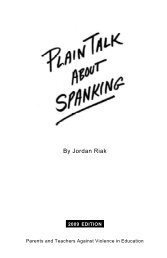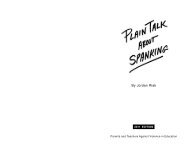Plain Talk about Spanking - Project NoSpank
Plain Talk about Spanking - Project NoSpank
Plain Talk about Spanking - Project NoSpank
You also want an ePaper? Increase the reach of your titles
YUMPU automatically turns print PDFs into web optimized ePapers that Google loves.
other and for adults to mistreat children.<br />
When children, whose personalities have been formed<br />
in violent households, grow up and have children of their<br />
own, they find it very difficult to break free from the<br />
behaviors they have witnessed and experienced. The skills<br />
they apply to family life will be the poor ones they learned<br />
from their parents, and they are likely to perpetuate the cycle<br />
of abuse through their own innocent children.<br />
As spanking disappears from family life, other forms of<br />
domestic violence will also disappear.<br />
Escalation<br />
Physical injuries and deaths of children caused by their<br />
caretakers often are the consequence of physical punishment.<br />
Perpetrators of even the most horrendous acts against<br />
children typically explain that the child's misbehavior called<br />
for punishment, and the outcome was unintended.<br />
"Accidental" is the child abuser's all-weather alibi.<br />
Many infants' and toddlers' deaths attributed to accidents<br />
such as falling out of the crib, falling down the stairs, or<br />
accidentally drowning in the bathtub because the parent was<br />
distracted by a telephone call, would be reclassified as<br />
homicides if the truth were known. Sometimes the victim is<br />
blamed for his own misfortune, for example: "he bruises<br />
easily," "has soft bones," "is accident prone," "she brought<br />
it on herself," or "wouldn't hold still."<br />
Some defenders of spanking caution that spanking, to<br />
be done correctly, must be done methodically and with<br />
deliberation. "Never spank in anger," they say. The implicit<br />
message here is that it's quite all right to hurt another person<br />
on condition that one does it calmly. (Sadists enthusiastically<br />
endorse this formula.) But it is highly unlikely that anyone<br />
being abused - child or adult - notices or cares <strong>about</strong> the<br />
abuser's frame of mind.<br />
Many spankers are habituated to the practice because it<br />
provides them with an instant outlet for their feelings of<br />
frustration and anger - not because they've found it an<br />
effective way to improve a child's behavior. And because<br />
acts of violence, by their very nature, tend to escalate as<br />
they are indulged, there is no safe way to hit a child.<br />
<strong>Spanking</strong> and sexual molestation<br />
Spanked children learn that their bodies are not their personal<br />
property. <strong>Spanking</strong> trains them that even their sexual areas<br />
are subject to the will of adults. The child who submits to a<br />
spanking on Monday is not likely to say no to a molester on<br />
Tuesday. It's time spankers realized that – no matter what<br />
else they think they are accomplishing – they are setting<br />
children up to be easy prey for predators.<br />
<strong>Spanking</strong> the buttocks and sexual development<br />
Medical science has long recognized and documented in great<br />
detail how being struck on the buttocks can stimulate sexual<br />
feelings. Children are especially susceptible. The tragic<br />
consequence for many children who have been punished by<br />
spanking is that they form a connection between pain,<br />
humiliation and sexual arousal that endures for the rest of<br />
their lives.<br />
In Slaughter of the Innocents, David Bakan writes: "...The<br />
buttocks are the locus for the induction of pain in a child.<br />
We are familiar with the argument that it is a safe 'locus' for<br />
spanking. However, the anal region is also the major erotic<br />
region at precisely the time the child is likely to be beaten<br />
there. Thus it is aptly chosen to achieve the result of deranged<br />
sexuality in adulthood..." 1971 (p. 113)<br />
The pornography and prostitution industries do a thriving<br />
business catering to the needs of countless unfortunate<br />
individuals whose sexual development has been derailed by<br />
childhood spankings. If we put all other considerations aside,<br />
this should be reason enough never to spank a child.<br />
The physical dangers of hitting the buttocks<br />
Located deep in the buttocks is the sciatic nerve, the largest<br />
nerve in the body. A severe blow to the buttocks, particularly<br />
with a blunt instrument, could cause bleeding in the muscles<br />
that surround that nerve, possibly injuring it and causing<br />
impairment to the involved leg.<br />
In addition to nerve damage and soft tissue damage, a<br />
blow to the buttocks can cause injury to the tailbone (coccyx)<br />
or sacrum. It sends force waves upward through the spinal<br />
column possibly causing disc compression or compression<br />
fractures of vertebral bones.<br />
Some people, in their attempt to justify battering<br />
children's buttocks, claim that God or nature intended that<br />
part of the anatomy for spanking. That claim is brazenly<br />
perverse. No part of the human body was made to be<br />
mistreated.<br />
Physical danger of hitting the hands<br />
The child's hand is particularly vulnerable because its<br />
ligaments, nerves, tendons and blood vessels are close to the<br />
skin, which has no underlying protective tissue. Striking the<br />
hands of younger children is especially dangerous to the<br />
growth plates in the bones, which, if damaged, can cause<br />
deformity or impaired function. Striking a child's hand can<br />
also cause fractures, dislocations and lead to premature<br />
osteoarthritis.<br />
Shaking<br />
Being shaken can cause a child blindness, whiplash, brain<br />
damage, spinal cord injury and even death.<br />
<strong>Spanking</strong> at home, performance at school<br />
Perceptive teachers will tell you that the children who exhibit<br />
the most serious behavior problems at school also have the<br />
most troubled home environments. For many of these<br />
children, the battle zone which is their home life carries over<br />
into their school life. This sets them up for academic failure<br />
-3-





